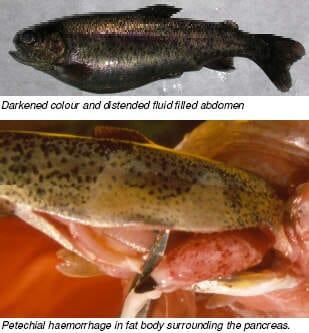Status Report
Viral haemorrhagic septicaemia (VHS) was diagnosed in rainbow trout at a fish farm in North Yorkshire on 26 May 2006. This is the first record of a VHS outbreak in mainland GB. Statutory controls were promptly placed on the affected farm and in order to prevent the further spread of disease the fish stocks were humanely destroyed under the supervision of the Centre for Environment, Fisheries and Aquaculture Science (Cefas). The farm has now been drained of water and is preparing for disinfection.
To facilitate the containment of the disease and to establish the extent of the infection statutory controls were placed on all fish
farms in the Ouse catchment.
The Cefas Fish Health Inspectorate have now inspected all fish farms holding susceptible species in the Ouse catchment. There was no evidence of clinical disease in any of the farms, and samples are now being tested for the presence of the virus.
In addition the Environment Agency suspended all fish introduction and movement consent applications in the catchment whilst investigations into the extent of the disease outbreak are conducted. Testing of the wild fish population adjacent to the infected farm is underway. Preliminary results have revealed no evidence of disease in the wild fish. Investigations are also taking place into the potential source of the infection.
The Disease
 Viral haemorrhagic septicaemia (VHS) is the most serious disease of rainbow trout in the European Union member states. Viral haemorrhagic septicaemia virus (VHSV) is a rhabdovirus, a member of the largest group of fish pathogenic viruses and in Europe, three main subtypes of VHSV are known.
Viral haemorrhagic septicaemia (VHS) is the most serious disease of rainbow trout in the European Union member states. Viral haemorrhagic septicaemia virus (VHSV) is a rhabdovirus, a member of the largest group of fish pathogenic viruses and in Europe, three main subtypes of VHSV are known.
VHS is principally a disease of farmed rainbow trout in fresh water, but most salmonid fish are considered susceptible, as are whitefish (Coregonus spp), grayling and pike. There is no evidence of natural infection of Atlantic salmon.
Clinical Signs
Three main stages are observed:
1. Acute Stage: Darkening of body colour, exophthalmia (bulging eye), bleeding around eye and fin bases, pale gills with pin point (petechial) haemorrhaging. Internally there are petechial haemorrhages on the surfaces of fatty tissue, intestine, liver, swim bladder and in the muscle and there may be fluid in the body cavity. High mortalities can occur very rapidly at this stage.
2. Sub Acute or Chronic Stage:
Body colour continues to darken and pop eye becomes more pronounced. Fish are severely anaemic and the paleness is particularly evident in the abdomen. The gills turn grey white, but haemorrhaging of the gills is rarely evident. Fish swim with rotating movements around the body axis (cork screwing)
3. Nervous final stage: The most obvious sign of this stage is the marked abnormality in the swimming behaviour (cork screwing). All
other signs of the infection are reduced and mortality rate may decline.
Information and Contact
VHS is a notifiable disease and if you suspect the presence of VHS in any fish population, or you would like further information on the disease, please contact the Fish Health Inspectorate at Cefas or FRS without delay.
Further Information
For additional information on Viral Haemorrhagic Septicaemia by the OIE, click here
Source: Cefas - June 2006

